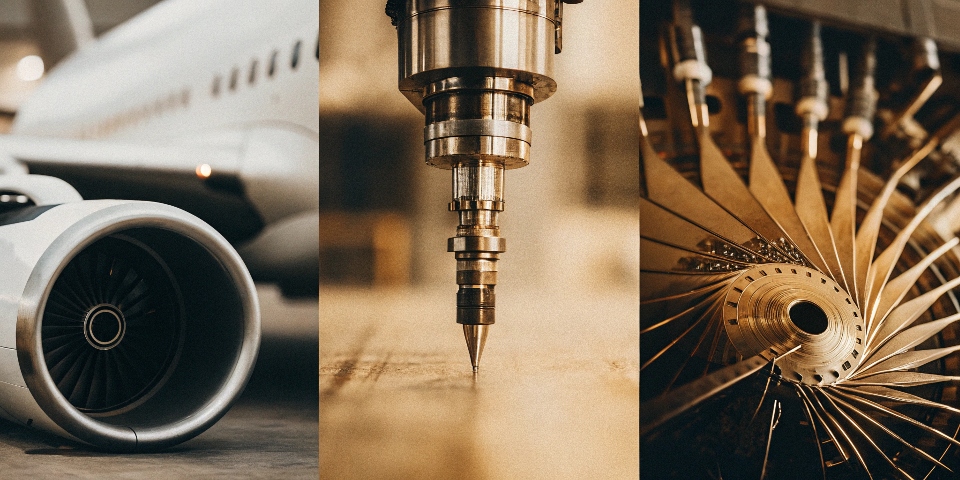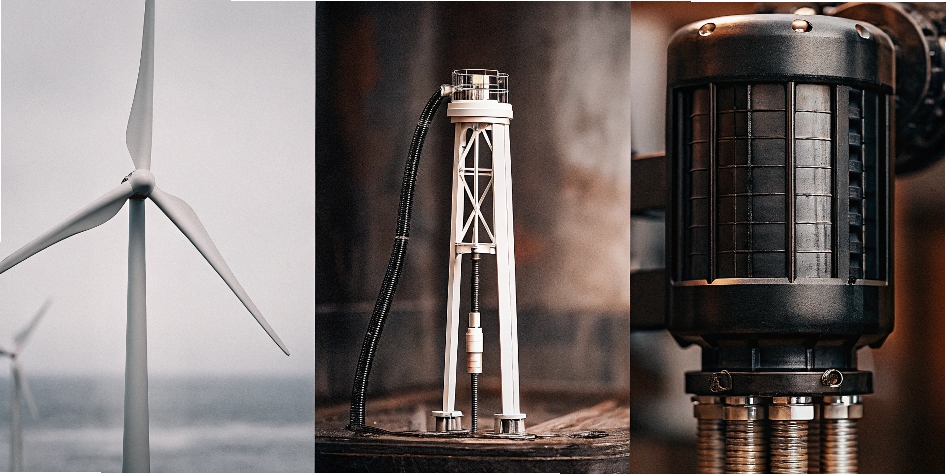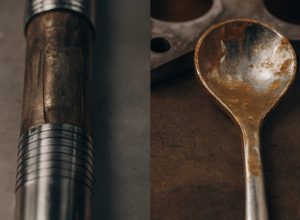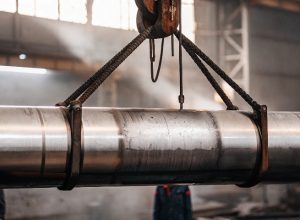Die Industrie braucht starke, leichte und langlebige Materialien. Doch herkömmliche Metalle sind oft zu schwer oder korrodieren leicht. Aus diesem Grund wird Titan immer mehr zur ersten Wahl für anspruchsvolle Anwendungen.
Das Wachstum von Titan wird durch sein hervorragendes Verhältnis von Festigkeit zu Gewicht, seine Korrosionsbeständigkeit und seine Biokompatibilität angeheizt. Diese Eigenschaften machen es für Branchen wie Luft- und Raumfahrt, chemische Verarbeitung und Medizin unverzichtbar. Auch die neue Nachfrage aus dem Energiesektor treibt die rasche Expansion auf dem Weltmarkt voran.
Sie sehen die Schlagzeilen über das Wachstum des Titans, aber was bedeutet das wirklich für Ihre Projekte? Es handelt sich nicht nur um einen vorübergehenden Marktanstieg. Es handelt sich um einen grundlegenden Wandel in der Materialwissenschaft, der von Leistungsanforderungen angetrieben wird, die nur Titan erfüllen kann. Das Verständnis dieses Trends ist der Schlüssel zu intelligenten Beschaffungsentscheidungen. Lassen Sie uns aufschlüsseln, woher diese Nachfrage kommt und was sie für Ihr Unternehmen bedeutet.
Ist Titan sehr gefragt?
Man hört viel über Angebot und Nachfrage von Titan. Es ist schwer zu sagen, ob es sich dabei nur um einen Hype handelt oder um einen echten Trend, der die Beschaffungsstrategie Ihres Unternehmens beeinflusst.
Ja, die Nachfrage nach Titan ist sehr groß. Der Weltmarkt wächst jedes Jahr um 6-8%. Im Jahr 2024 wird die Titanschwammproduktion voraussichtlich 240.000 Tonnen überschreiten. In meinem Werk haben die Aufträge aus Europa und Nordamerika im Vergleich zum Vorjahr um 20% zugenommen.
Die Zahlen belegen eindeutig eine starke und anhaltende Nachfrage nach Titan. Ich sehe das aus erster Hand in unseren Auftragsbüchern. Dieses Wachstum ist nicht nur ein einzelner Datenpunkt, sondern spiegelt eine breite industrielle Verlagerung wider. Schauen wir uns die Faktoren, die dies bewirken, genauer an.
Die globale Produktionsskala
Die prognostizierte Produktion von über 240.000 Tonnen Titanschwamm ist eine gewaltige Zahl. Titanschwamm ist die rohe, poröse Form von Titanmetall. Es ist der Ausgangspunkt, bevor wir es schmelzen und Legierungen hinzufügen, um bestimmte Qualitäten herzustellen. Dieses Produktionsniveau zeigt, dass die Primärmetallhersteller ihre Kapazitäten ausbauen, um den steigenden weltweiten Bedarf zu decken. Für Produktmanager wie Lisa bedeutet dies, dass zwar das Angebot an Rohstoffen zunimmt, aber auch der Wettbewerb um zertifizierte Fertigprodukte steigen wird, insbesondere bei hochreine Sorten1.
Regionale Nachfragetreiber
Bei meiner Arbeit habe ich im Vergleich zum Vorjahr einen Anstieg der Aufträge unserer Kunden in Europa und Nordamerika um 20% festgestellt. Das gilt nicht nur für eine Branche. Sie kommen aus der Luft- und Raumfahrt, der chemischen Verarbeitung und sogar aus aufstrebenden Unternehmen der Medizintechnik. Ich spreche oft mit Produktmanagern, die eine zuverlässige Lieferkette benötigen. Sie versuchen, hochwertiges Titan für die Entwicklung neuer Produkte und für bestehende Produktionslinien zu beschaffen.
Die folgende einfache Tabelle zeigt, was dieses Wachstum für die Beschaffungsplanung bedeutet.
| Metrisch | Datenpunkt | Auswirkungen für Produktmanager |
|---|---|---|
| Jährliche globale Wachstumsrate | 6-8% | Rechnen Sie mit anhaltendem Preisdruck und längeren Vorlaufzeiten. Planen Sie die Beschaffung weit im Voraus. |
| 2024 Prognose der Schwammproduktion | > 240.000 Tonnen | Das Angebot nimmt zu, hält aber möglicherweise nicht mit der Nachfrage nach Speziallegierungen Schritt. |
| Auftragswachstum unseres Werks im Jahresvergleich (EU/NA) | +20% | Ein starker Wettbewerb um hochwertige Materialien von zertifizierten Herstellern ist die neue Normalität. |
In welcher Branche wird am meisten Titan verwendet?
Sie müssen wissen, wohin sich das weltweite Titanangebot entwickelt. Wenn Sie den größten Abnehmer kennen, können Sie Marktverschiebungen und potenzielle Engpässe für den Bedarf Ihrer eigenen Branche vorhersehen.
Die Luft- und Raumfahrtindustrie ist mit großem Abstand der größte Abnehmer von Titan. Sie verbraucht über 40% aller weltweit hergestellten Titanlegierungen. In meinem Werk werden etwa 60% unserer hochwertigen Titanplatten und Schmiedeteile speziell für die Luft- und Raumfahrtindustrie hergestellt.
Die Verbindung zwischen Titan und der Luft- und Raumfahrt ist grundlegend. Die Eigenschaften dieses Metalls sind perfekt auf die extremen Anforderungen der Luftfahrt abgestimmt. Das Verständnis dieser Beziehung hilft anderen Branchen, sich auf dem Zuliefermarkt zurechtzufinden.
Warum die Luft- und Raumfahrt dominiert
Die Luft- und Raumfahrt benötigt Materialien, die unglaublich stark, aber auch sehr leicht sind. Jedes Kilogramm, das beim Gewicht eines Flugzeugs eingespart wird, führt zu einer besseren Treibstoffeffizienz und einer höheren Nutzlastkapazität. Hier kommt die hohe Festigkeit des Titans Stärke-Gewichts-Verhältnis2 ist entscheidend. Stahl ist stark, aber zu schwer. Aluminium ist leicht, aber nicht stark genug für hochbelastete Teile. Titanlegierungen wie Ti-6Al-4V (Grade 5) bieten das perfekte Gleichgewicht. Sie werden für kritische Strukturteile verwendet, darunter Triebwerkskomponenten, Fahrwerke und Befestigungselemente. Diese Teile müssen während des Starts, des Flugs und der Landung enormen Belastungen standhalten.
Gefragte Materialformen
Mein Werk ist auf die Herstellung von Titanplatten und Schmiedeteilen spezialisiert. Es ist keine Überraschung, dass 60% dieser Produktion an Kunden aus der Luft- und Raumfahrtindustrie gehen. Platten werden zum Bau von Teilen der Flugzeugzelle verwendet, während Schmiedeteile für die Herstellung komplexer, nahezu endkonturierter Teile wie Fahrwerkskomponenten und Triebwerksscheiben unerlässlich sind. Durch das Schmieden wird die Kornstruktur des Metalls ausgerichtet, was seine Festigkeit und Ermüdungsbeständigkeit erheblich erhöht. Dies ist eine unabdingbare Voraussetzung für Teile, bei denen ein Versagen nicht in Frage kommt.
Auswirkungen auf andere Branchen
Wenn die Nachfrage in der Luft- und Raumfahrt steigt, verknappt sich das Angebot an hochwertigem Titan für alle. Das ist etwas, woran ich Produktmanager wie Lisa im Bereich der chemischen Ausrüstung immer wieder erinnere. Derselbe hochreine Schwamm, der für die Schaufeln eines Düsentriebwerks benötigt wird, ist auch das Ausgangsmaterial für einen chemischen Hochleistungsreaktor. Das bedeutet, dass sich ein Anstieg der Flugzeugaufträge direkt auf die Verfügbarkeit und die Kosten von Titan für chemische, medizinische und andere industrielle Anwendungen auswirken kann. Daher ist eine sorgfältige langfristige Planung unerlässlich.
Was ist die wichtigste Verwendung von Titan?
Sie wissen, dass die Luft- und Raumfahrt die größte Industrie ist. Aber welche spezifischen Teile oder Anwendungen verbrauchen all dieses Material? Wenn Sie dies wissen, können Sie die Anforderungen an die Materialqualität und die Marktdynamik besser verstehen.
Die größte Einzelanwendung für Titan sind die Strukturkomponenten von Flugzeugen, insbesondere Düsentriebwerke und Flugzeugzellen. Für diese Anwendungen werden riesige Mengen an Hochleistungslegierungen benötigt, die sowohl mengen- als auch wertmäßig den größten Anteil am Markt ausmachen.
Ein Blick auf die Produktion unseres Werks vermittelt ein klares Bild davon, wohin das Titan geht. Von den 3.500 Tonnen fertigen Titans, die wir jährlich produzieren, zeigt die Aufteilung, wo die Hauptnachfrage liegt. An erster Stelle steht die Luft- und Raumfahrt, aber auch andere wichtige Sektoren sind stark auf dieses Metall angewiesen.
Triebwerkskomponenten
Strahltriebwerke arbeiten unter extremen Bedingungen. Die Temperaturen in den Verdichterstufen können 600°C (1100°F) übersteigen, und die Rotationskräfte sind immens. Titanlegierungen, insbesondere Ti-6Al-4V, werden für einen großen Teil des Triebwerks verwendet, darunter die großen Fanschaufeln an der Vorderseite, Verdichterschaufeln, Scheiben und Gehäuse. Die Fähigkeit des Metalls, seine Festigkeit bei hohen Temperaturen beizubehalten und gleichzeitig viel leichter zu sein als Superlegierungen auf Nickelbasis, macht es für diese Komponenten unersetzlich. Dies verbessert die Motorleistung und den Kraftstoffverbrauch.
Eine Aufschlüsselung der Marktanwendungen
Der beste Weg, sich ein vollständiges Bild zu machen, ist, sich anzusehen, wohin unsere fertigen Produkte gehen. Ich arbeite eng mit unseren Produktionsdaten, die eine klare Aufschlüsselung liefern. Die Luft- und Raumfahrt ist zwar das größte Segment, aber die chemische Verarbeitungsindustrie steht an zweiter Stelle und ist sehr wichtig für uns. Das ist der Markt, in dem Lisa arbeitet. Ihr Bedarf an korrosionsbeständigen Werkstoffen für Reaktoren und Wärmetauscher ist eine wichtige Triebfeder für unser Geschäft. Es folgt der medizinische Bereich, der Titan von höchster Reinheit für Implantate verlangt.
| Marktsegment | Die Leistung unserer Anlage % | Wichtige Anwendungen |
|---|---|---|
| Luft- und Raumfahrt | 40% | Düsentriebwerke, Flugzeugzellen, Fahrwerk |
| Chemische Verarbeitung | 30% | Reaktoren, Wärmetauscher, Rohre, Ventile |
| Medizinische | 15% | Hüft- und Knieimplantate, chirurgische Instrumente |
| Andere | 15% | Marine, Sport und Konsumgüter |
Was ist der Zukunftstrend von Titan?
Wer für die Zukunft plant, muss wissen, wohin sich die Materialien bewegen. Sie wollen nicht von neuen Nachfragespitzen oder technologischen Veränderungen, die Ihre Lieferkette betreffen, überrascht werden.
Der Zukunftstrend für Titan ist die Diversifizierung über die Luft- und Raumfahrt hinaus. Ein starkes Wachstum ist bei Anwendungen im Bereich der Wasserstoffenergie zu verzeichnen, etwa bei Hochdrucktanks und -ventilen. Offshore-Windkraft und Elektrofahrzeuge werden ebenfalls zu wichtigen Antriebskräften. Außerdem werden fortschrittliche Legierungen für medizinische und chemische Anwendungen entwickelt.
Die Luft- und Raumfahrt wird zwar ein Kernmarkt bleiben, aber ich bin begeistert von den neuen Möglichkeiten, die sich für Titan eröffnen. Meine F&E-Arbeit konzentriert sich zunehmend auf die Entwicklung von Materialien für diese Anwendungen der nächsten Generation.
Die neue Energie-Grenze
Der weltweite Vorstoß für saubere Energie eröffnet Titan enorme Möglichkeiten. In der Wasserstoffwirtschaft ist Titan unverzichtbar. Es ist eines der wenigen Metalle, das der Wasserstoffversprödung bei hohem Druck widersteht, was es zum idealen Werkstoff für Speichertanks, Ventile und Rohrleitungen macht. Ein weiterer Bereich ist die Offshore-Windkraft. Salzwasser ist extrem korrosiv, aber Titan ist dagegen praktisch immun. Es gibt immer mehr Anfragen für den Einsatz von Titan in Wärmetauschern und anderen kritischen Komponenten von Offshore-Windturbinen, um deren Lebensdauer zu verlängern und den Wartungsaufwand zu verringern. Diese neuen Energiesektoren werden in den nächsten zehn Jahren zu den Hauptabnehmern von Titan gehören.
Fortschrittliche Materialentwicklung
Um diesen künftigen Bedarf zu decken, arbeitet mein Team an der Entwicklung neuer Titanlegierungen. Zum Beispiel verfeinern wir unsere Produktion von Titan Grad 23, auch bekannt als Ti-6Al-4V ELI (Extra Low Interstitials). Der geringere Sauerstoffgehalt verleiht ihm eine höhere Bruchzähigkeit, wodurch es sich ideal für medizinische Implantate wie künstliche Hüften und zahnmedizinische Vorrichtungen eignet. Für die chemische Industrie, die Lisas Schwerpunkt ist, verbessern wir unsere Titan-Palladium-Legierungen wie Grade 7 und Grade 11. Durch die Zugabe einer geringen Menge Palladium wird die Beständigkeit gegen Spaltkorrosion in sauren und chloridhaltigen Umgebungen drastisch erhöht. Dadurch können Chemieanlagen unter aggressiveren Bedingungen sicherer und effizienter arbeiten.
Schlussfolgerung
Das Wachstum von Titan wird durch seine unübertroffenen Eigenschaften angetrieben. Heute dominiert die Luft- und Raumfahrt die Nachfrage, aber die Zukunft gehört neuen Anwendungen in den Bereichen Energie und Medizin, die den Markt für alle neu gestalten werden.



[^2].](https://titonestmetal.com/wp-content/uploads/2025/07/the-aerospace-industry-is-the-biggest-user-of-ti.jpg)









